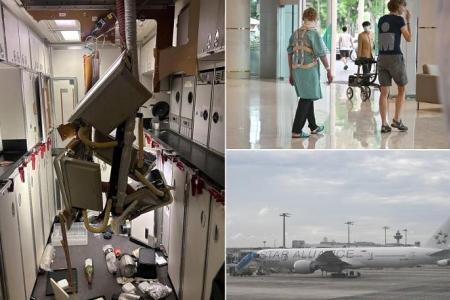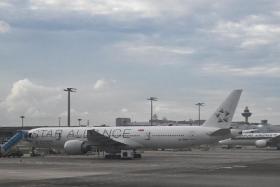What the SQ321 turbulence incident left in its wake
SINGAPORE/BANGKOK – A week since she was taken to a Bangkok hospital after extreme turbulence rocked the Singapore Airlines (SIA) flight she was on, dental hygienist Karen Archer just wants “to get well and go home”.
The 64-year-old Briton, who cracked three small spinal bones in the ordeal that hit Flight SQ321, was on her way from London to meet a friend for a five-day holiday in Singapore.
Ms Archer is unsure what treatment she will need in the coming weeks, but she told The Straits Times on May 28 that doctors hope to remove her neck and body brace sometime in July and get her ready to fly home.
The thought of returning home is also uppermost on the minds of Malaysian Eva Khoo’s injured family members.
The Kuala Lumpur-based event specialist had travelled to Bangkok, where SQ321 made an emergency landing, soon after hearing that her brother and sister-in-law, and their extended family, were hurt.
While their conditions have stabilised and they are now in regular wards, Ms Khoo, 47, said the thought of getting on a plane to Malaysia is unsettling them.
“They want to go home, but they need time to overcome the phobia of flying. It’s not a small thing,” she said on May 27.
SQ321 – one of SIA’s four daily services from London to Singapore – was cruising high above the Irrawaddy Basin in Myanmar on the afternoon of May 21.
The jet had completed more than three-quarters of its 13-hour journey from the British capital, and a meal service was under way. Until then, the flight had been, in a passenger’s words, “quite smooth”.
But, in an instant, everything changed.
For more than a minute, the wide-body aircraft with 211 passengers and 18 crew members found itself in the grip of extreme turbulence, sending unrestrained passengers airborne as the plane was swept into rapid climbs and drops.
The mayhem left a chaotic cabin in its wake, claiming the life of a 73-year-old British man, who was said to have suffered a heart attack, and injuring dozens more. It was SIA’s first fatal aviation accident since the SQ006 crash in Taiwan in 2000, which killed 83.
A week after the ordeal forced the Boeing 777-300ER to divert to Bangkok, 34 passengers remain hospitalised in the Thai capital. All injured crew members had returned to Singapore as at May 27.
As the passengers and crew come to terms with the harrowing experience, investigators are poring over data from the jet’s cockpit voice and flight data recorders to try to stitch together what happened.
The SIA plane, a 16-year-old workhorse, is back at Changi Airport. It was cleared to leave Bangkok’s Suvarnabhumi Airport five days after the incident, which hogged headlines around the world for days.
The flight
For 62 seconds, the twin-aisle jet climbed and dropped rapidly, beginning at 3.49pm (Singapore time) on May 21, just over 10 hours after it left London’s Heathrow Airport.
In this brief moment, the plane climbed from its cruising altitude of 37,000 feet to 37,400 feet, then sank rapidly to 36,975 feet before settling back onto its cruising altitude, based on data from flight-tracking site Flightradar24.
Its data is derived from a global network of ground-based receivers, satellites and radars that receive flight data from aircraft transponders.
The data showed that the plane first attained a climb rate of 1,664 feet per minute (fpm) – or 507m per minute, double the height of the 52-storey Capital Tower in Singapore – before descending at 1,536fpm six seconds later.
It rapidly returned to a climb rate of about 900fpm three seconds later, then dropped at 1,536fpm after another 20 seconds.
Passengers who were not strapped in reported being flung against the ceiling of the cabin, while others awoke on the floor to a scene of pandemonium: cries and blood, as well as a wrecked cabin, with panels dangling from the ceiling, and luggage, meal trays and food strewn about.
Crew members, some of whom were seen bleeding and burnt by hot beverages, were not spared the brunt.
Apart from 41 Singaporeans on board, the other 170 passengers were from 16 countries, including Australia, New Zealand, Malaysia and the UK.
The aftermath
A little under an hour after the severe turbulence struck, SQ321 touched down in Bangkok at 4.45pm (Singapore time). It was met quickly by emergency staff who dispatched the injured to hospitals.
In the hours that followed, an SIA team as well as investigators from Singapore’s Transport Safety Investigation Bureau (TSIB) reached Bangkok to help the passengers and search for answers.
In Singapore, there were emotional scenes at Changi Airport early the next morning, as anxious family members were reunited with their loved ones. They were among the first batch of 143 passengers and crew flown from Bangkok to Singapore on a relief SIA flight.
Meanwhile, condolences from government leaders streamed in for the family of the passenger who died. Musical theatre director Geoff Kitchen and his wife had been on their way to a six-week holiday, with plans to stop in Singapore, Indonesia, Japan and Australia.
The airline’s chief executive Goh Choon Phong publicly apologised for the traumatic experience that everyone on board had gone through.
The incident also swiftly forced a change in SIA’s turbulence protocols.
On May 23, the airline confirmed that in-flight meal services will be suspended when the seat-belt sign is turned on. Cabin crew will also return to their seats with their seat belts fastened, as the airline adopts a more cautious approach.
Its past practice was to suspend only the serving of hot drinks in turbulent conditions.
The extent of the injuries wrought by the turbulence has become clearer in the days after the incident.
Many had serious injuries, involving the spinal cord, brain and skull, as well as bone and muscle.
A crew member had to undergo spinal surgery after injuring his head and back, while Ms Khoo’s pregnant sister-in-law was flung onto an adjacent seat, fracturing her back.
At Samitivej Srinakarin Hospital in Bangkok, where most of the injured passengers have been hospitalised, SIA staff were tight-lipped when approached by reporters.
For Ms Khoo’s loved ones, the long-term impact of their injuries is unclear.
It is likely that they will have to continue receiving treatment back in Malaysia, said Ms Khoo, whose brother still has trouble walking.
Mr Khoo Boo Leong, 38, was flung from his seat, hitting the overhead luggage compartment before falling onto the aisle. He was treated in intensive care before being moved into a normal ward.
Beyond the physical injuries caused by the turbulence, the mental trauma may linger among the injured long after the event, with recovery potentially lasting years, psychologists said.
While SIA has received plaudits for its management of the crisis and its regular updates, its response was not without hiccups.
The carrier had to apologise to an injured couple after an Australian man lamented a lack of information from the airline. The man, whose wife needed a medical evacuation, said the initial absence of information included whether he would be able to make an insurance claim.
Mr Goh, SIA’s chief, later met him and other passengers.
Ms Khoo, too, said the issue of compensation is up in the air.
Her brother and sister-in-law, who work in sales, would likely not be able to work for a few months. Doctors have also advised his sister-in-law’s father, who owns a frozen-food business, to stop strenuous activity for at least six months post-recovery, she said.
“We’re still unclear on the compensation part,” she added.
News agency Reuters reported that injured passengers would likely be eligible for compensation, although the sum each receives could vary widely, even for identical injuries, because of a global treaty.
Spotlight on turbulence
The extreme turbulence that rocked SQ321 has focused global attention on the phenomenon, which is common on flights but rarely happens on this magnitude.
Five days after the incident, a Qatar Airways flight from Doha to Ireland hit turbulence that reportedly lasted less than 20 seconds during food and drinks service. Twelve people on the Boeing 787-9 Dreamliner were hurt.
Turbulence is caused by irregular airflow motions, and can be triggered by a variety of factors, including storms and strong air currents such as jet streams.
Views on what could have caused SQ321 to be hit by such extreme turbulence are divided.
Some aviation experts suggested it was “clear air turbulence”, which happens without warning and is brought on by changes in wind speed, air temperature or pressure over short distances.
Others said fast-building thunderstorms near the aircraft’s flight path could have been a contributory factor.
This is not the first time turbulence on SIA flights has led to serious injury. ST’s checks of the public records showed there were six other instances in the past two decades investigated by the TSIB and its forerunner, the Air Accident Investigation Bureau.
All six accidents, which happened between June 2004 and January 2019, involved wide-body aircraft. The resulting injuries included rib cage, thigh bone, foot and wrist fractures.
It is an indication that even on big planes, such as the Boeing 777 or the double-deck Airbus A380, sudden turbulence can cause serious injury if passengers or crew members are not buckled up or are hit by flying debris.
Nevertheless, people’s emotional reaction to the SQ321 incident – magnified by the media attention – does change their perception of the risk and leads them to think these cases are more common than they are, said current affairs website The Conversation.
Injuries from turbulence remain extremely rare, and it is still much riskier to travel by car or motorcycle.
It could, however, be months before investigators release their full findings into what caused the pandemonium on SQ321.
The TSIB released its final reports on the past six turbulence-related accidents anywhere between 8½ months and nearly 2½ years after they happened, though most were made public within 19 months.
Get The New Paper on your phone with the free TNP app. Download from the Apple App Store or Google Play Store now


